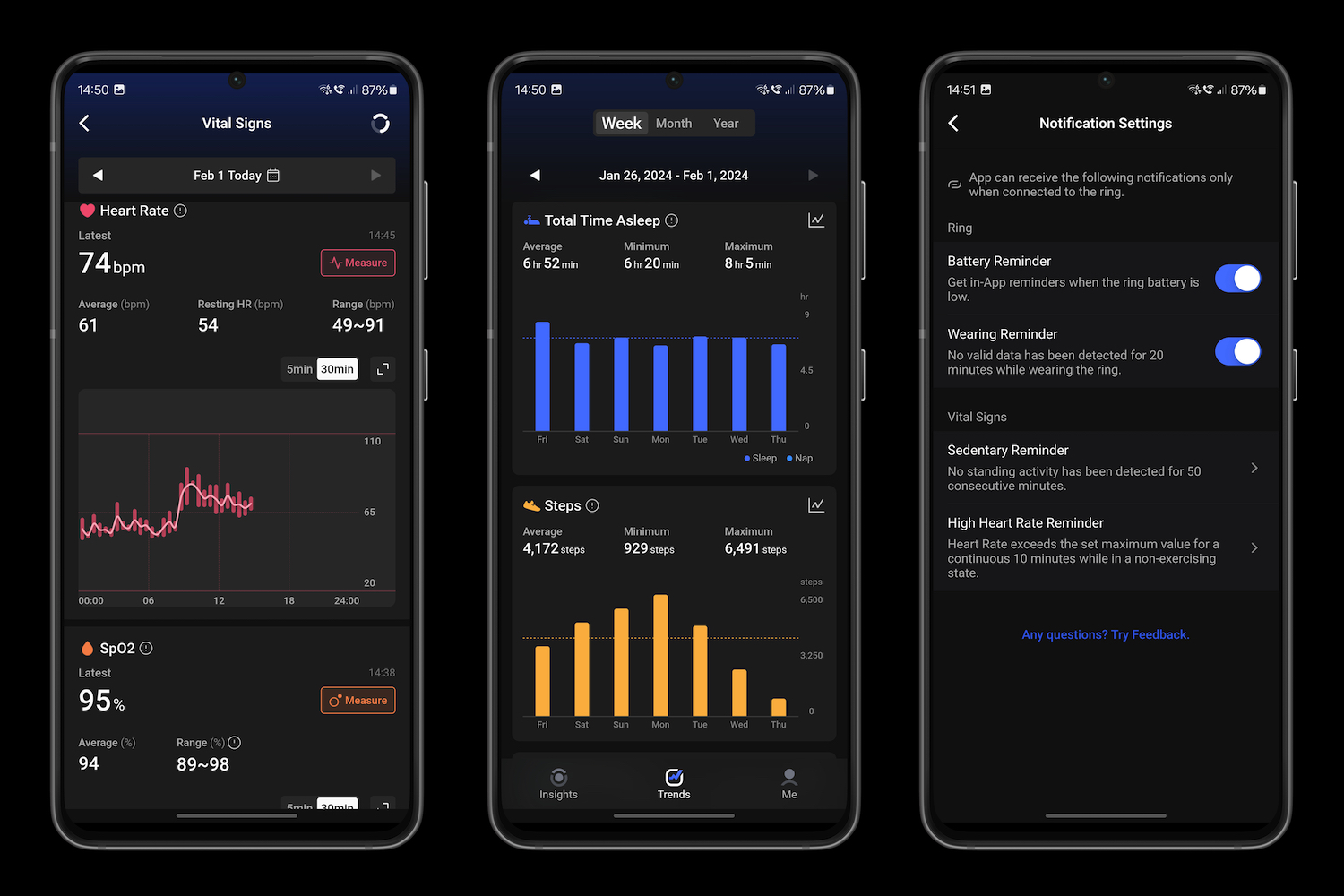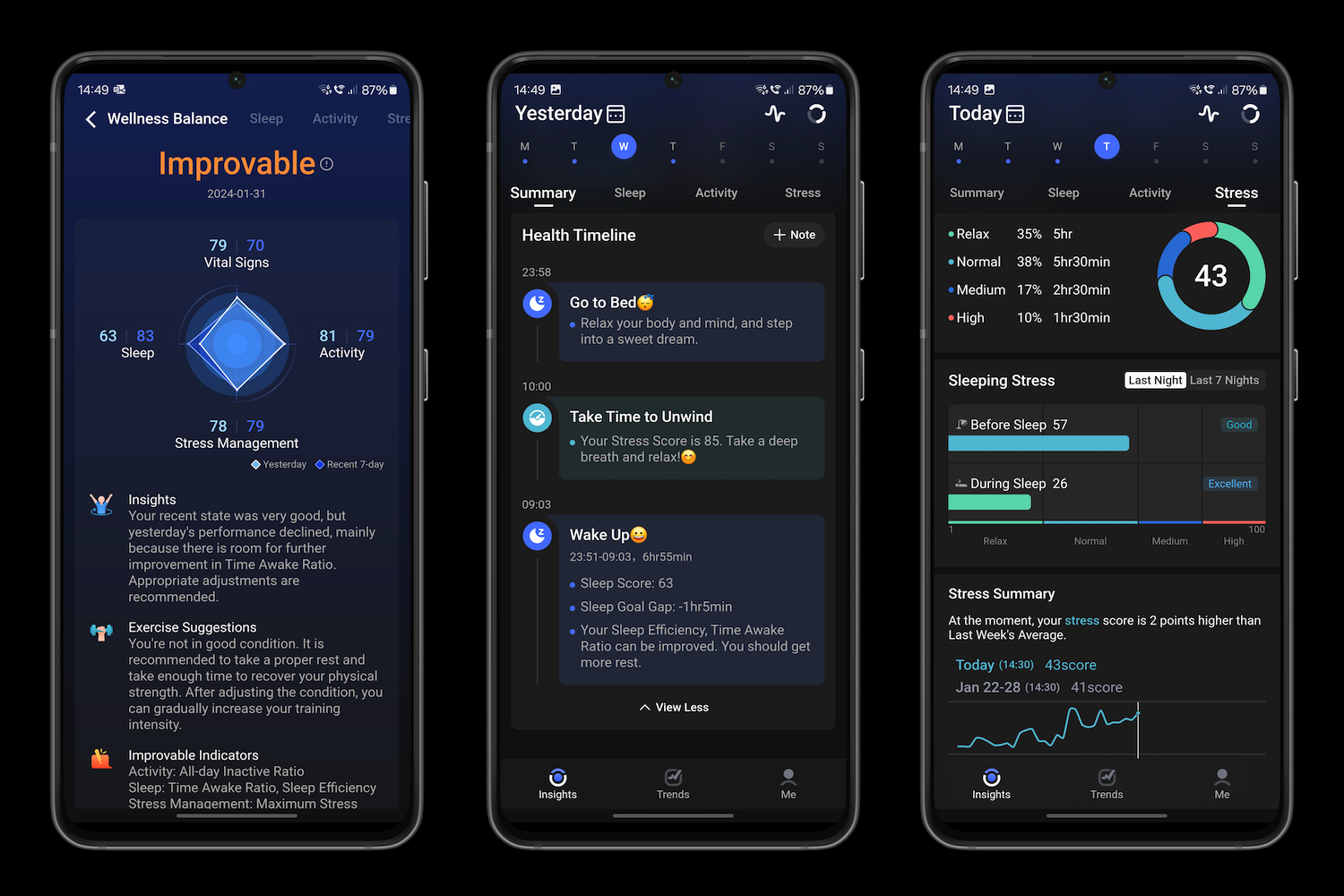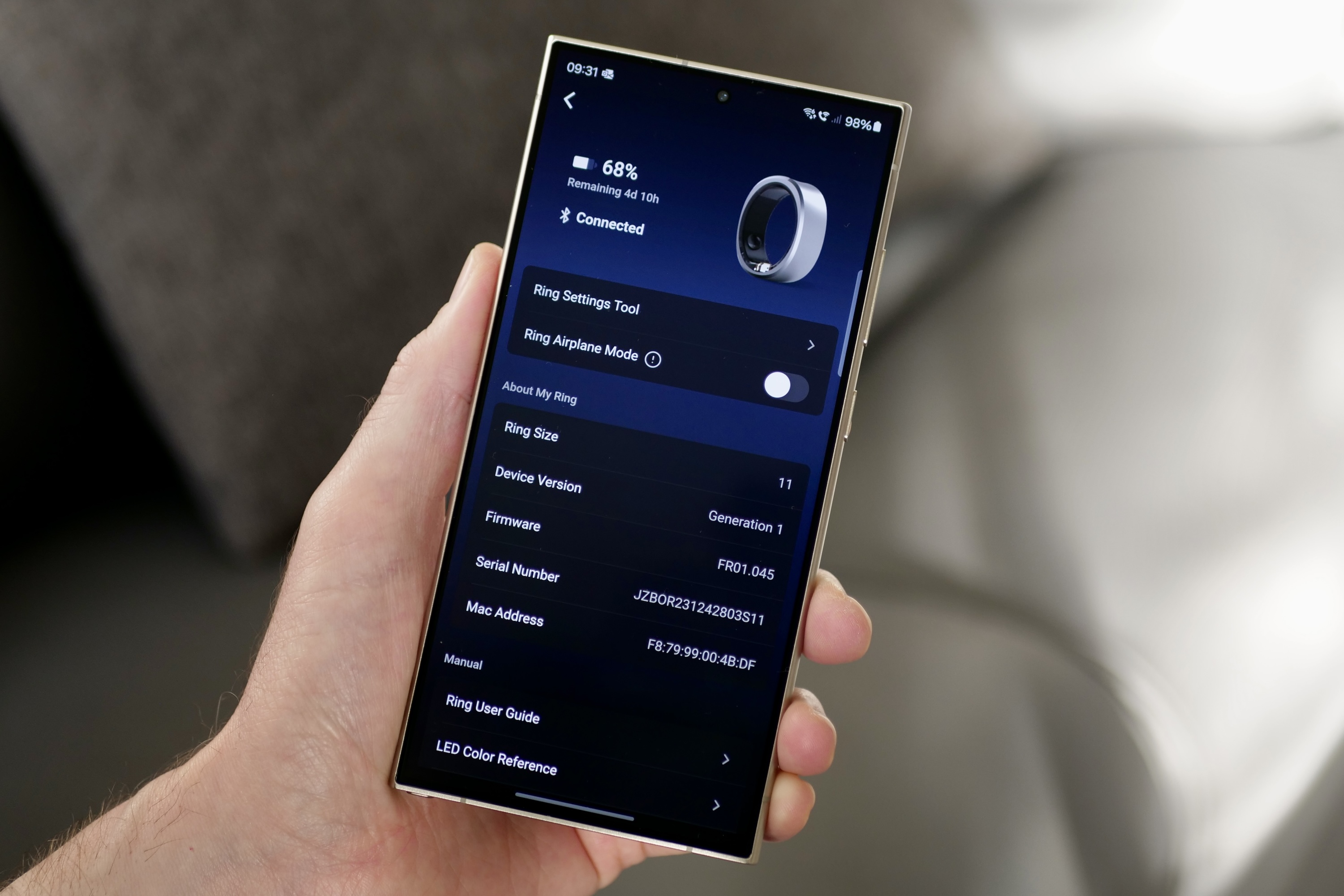
“The RingConn Smart Ring is very comfortable, perfectly suited to sleep tracking, and has a battery that lasts for a whole week.”
- Very comfortable to wear
- No app subscription
- Detailed sleep tracking
- Travel charging case included
- Seven days battery life
- No workout tracking
- App notifications haven't worked
- HRV and blood oxygen accuracy needs improvement
Naming a product “con” seems like a bad idea, regardless of how many n’s are used. But here we have the RingConn Smart Ring, a wearable health tracker that takes on the Oura Ring, the Ultrahuman Ring Air, and — in the future — the Samsung Galaxy Ring.
But will you feel conned out of $279 if you buy one? I’ve had the RingConn Smart Ring on my finger for a few weeks and can now tell you if it’s a swindle or not.
RingConn Smart Ring: design

The RingConn Smart Ring (hereafter often referred to as simply RingConn) is less of a ring and more of a squircle. The inner section is circular, but the outer part has a subtle rounded square shape — and it’s actually a real success. I’ve been wearing the RingConn Smart Ring on the middle finger of my left hand, with my Oura Ring in its usual place on the middle finger of my right hand. I started the same way when I reviewed the Ultrahuman Ring Air, but I had to swap it out with my Oura Ring as it was very uncomfortable to wear this way. I haven’t worn a ring on my left hand since then, but it only took a few hours to get used to the RingConn.
A big part of the reason it quickly became unnoticeable is not only the squircle shape, which you feel less between your fingers, but also the tapered edges of the ring. I haven’t suffered from any discomfort or awkwardness at all, and I have found it easy to wear 24 hours a day. The ring is thicker than the Oura Ring, and it does get caught on gloves. I notice it when gripping the steering wheel or gearstick in my car, more so than with the Oura Ring.

The RingConn is made of titanium with a plastic inner section where the sensors are located. It has an IP68 water and dust resistance rating, and my Moonlit Silver version weighs three grams, according to my scales (the same as my Oura Ring). I selected the same size RingConn Smart Ring as my Oura Ring, and I would say it fits a tiny bit larger, feeling just a touch looser on my finger. I’d recommend getting a sizing kit regardless of being able to add in your usual ring size at the time of purchase.
The RingConn Smart Ring has proved to be exceptionally comfortable to wear.
The RingConn Smart Ring’s titanium has a matte finish on the surface and polished sides, which likely helps visually minimize the ring’s bulk — it is quite substantial — but doesn’t make it overly flashy in this color scheme. I doubt the same can be said for the Pale Gold model, which looks perfect for the wannabe goodfella who cares about their sleep patterns. When you look very closely, the polished sides have picked up some scratches on my smart ring, but the matte sections still look new.

Whether you find the squircle shape endearing and quirky or rather bizarre and not at all ring-like will be down to personal preference. What you need to know is the RingConn Smart Ring has proved to be exceptionally comfortable to wear, and despite being slightly larger than the Oura Ring, it won’t interfere with everyday life — even when worn for 24 hours a day.
RingConn Smart Ring: what does it do?

Now you know the RingConn Smart Ring is equally as comfortable to wear as the Oura Ring, making it more comfortable than the Ultrahuman Ring Air, what will it do once it’s on your finger? The unfortunate answer is not a great deal at the moment. The company behind the smart ring lists various “developing functions” on its website as a teaser of what’s to come — workout tracking, mindfulness, meditation, cycle tracking — but the product I’m wearing today has none.
This makes it a fairly simple, very unobtrusive sleep tracker that keeps a watchful but passive eye on your daily activity. The Oura Ring looks like an Apple Watch next to it in terms of sheer functionality and variety of features. So, what does the RingConn Smart Ring do, exactly? It monitors sleep, stress, heart rate, blood oxygen levels, heart rate variability (HRV), skin temperature, and basic movement. It breaks each of these down into separate sections in the app, providing an overview of your sleep, activity, and stress level.

There really isn’t much more to it outside of presenting the data in the app. There’s no dedicated workout mode at all (yet, according to RingConn), and there’s no way to add a workout manually. The app shows activity data, steps, and calorie burn, but without any specific workout mode or recognition, it’s extremely basic. Runners, cyclists, and athletes of any type wanting to track their exploits and gain insight into their performance should look elsewhere.
It’s at this point you need to make a decision: Is this just the right amount of tracking for you, or not? If you primarily want a sleep tracker, then the RingConn will satisfy you. But if you want a wider health, fitness, and activity tracker — in-depth or otherwise — then one of the other top smart rings or a smartwatch should be at the top of your list; the RingConn Smart Ring will be too basic for you in its current form.
RingConn Smart Ring: what about the app?

Understanding the RingConn Smart Ring’s limitations today is important, as promised new features are never guaranteed to arrive in a timely fashion. Now you know what it does at the moment, there’s something else you should know: the app is free and does not require a subscription, making it different from the Oura Ring, which costs $6 per month to use.
The primary metric in the app is RingConn’s Wellness Balance, presented as a radar chart plotting your sleep, activity, vital signs, and stress management. It overlays your current performance with the day before’s stats. Tap it, and you get more detail on each individual section, plus a written overview of your current state and a headline indicator such as Good or Improvable. You can then dig into each section for individual data points.
It’s a solid, informative system with a clear, obvious overview of your status. The radar chart makes it simple to see where you lacked and when you’ve had a balanced day. The language used is to the point, such as “You’re not in a good condition” or “Your condition is improvable,” so you know where you are with the RingConn. There’s no complex language or terminology to wade through, like there is with the Ultrahuman Ring Air’s app.
It’s a solid, informative system with a clear, obvious overview of your status.
Elsewhere, there are graphs showing trends over a week, month, or year, and some easy-to-understand graphs on each of your vital statistics such as heart rate, blood oxygen, and HRV. Less helpful is the Health Timeline, which wants to give you an overview of your day but ends up repeating data found elsewhere, just presented less clearly with added emojis. I’ve had no issues with reliability or syncing, and I haven’t noticed any adverse battery consumption either. I’ve been using the RingConn Smart Ring connected to a Samsung Galaxy S24 Ultra, and the app is also available for iOS.

Despite app notifications being switched on for movement reminders and heart rate spikes, plus the correct permissions set in Android, it has remained stubbornly silent throughout. I certainly don’t want it to interrupt me too often, but it would be good if the notifications I requested arrived. It can link with Apple Health and Google Fit, but that’s all — another aspect that sees the RingConn fail to appeal to anyone keen on fitness.
The RingConn Smart Ring’s app isn’t as effortless or as beautifully presented as Oura’s app and isn’t sending notifications at the moment either, but it’s far more accessible than Ultrahuman’s app, and it’s excellent to see that at the moment there’s no subscription fee attached. The RingConn isn’t an approved medical device, so the advice and guidance it gives is quite broad, but I like that it’s clear where you should personally make some changes to help improve your condition.
RingConn Smart Ring: is it accurate?

The RingConn Smart Ring is best for tracking sleep at the moment, but how does it compare to the Oura Ring, and is the data it presents accurate? I’ve worn the RingConn for more than two weeks, and although it doesn’t specify a period of time it requires to learn your baseline figures, this should be enough for it to have a good idea.
Taking the most recent night’s sleep as an example, the RingConn Smart Ring was within 10 minutes of the Oura Ring’s total sleep time, returned almost the same Sleep Score, and around the same times for sleep stages. The average heart rate was within a beat of the Oura Ring, but the average HRV was always considerably higher. Along with the HRV, the RingConn also routinely showed a lower blood oxygen level than the Oura Ring, which I think has to do with the ring’s loose fit on my finger.

Because there’s no activity or workout tracking, it simply isn’t very good at understanding just how much you move during the day, and while I think the Oura Ring overcounts steps, the RingConn does seem to undercount them slightly. It doesn’t recognize workouts, and there’s no way to add one in manually, so you end the day always looking like you’ve done less than you have. It’s unfair to judge the accuracy of daytime movement too much, as it can’t monitor activity properly.
This is the RingConn’s problem. It’s a good sleep tracker, returning similar data to the Oura Ring. But outside of this, the software, features, and algorithms aren’t powerful or comprehensive enough to give you a detailed overview of your health. The promised workout feature and changes to the way it monitors daily activity and movement need to arrive soon for it to be taken seriously as an all-day activity tracker rather than just a competent sleep tracker as it is now.
RingConn Smart Ring: battery and charging

I’ve worn the RingConn Smart Ring for more than two weeks, but I’ve only had to charge it a few times. It lasted for six days on the first charge and still had enough charge for at least part of day seven when I decided to top it up. After my most recent charge, it’s headed towards seven days of use, according to the estimate provided in the app. Expect to get almost a full week out of the RingConn’s battery at the moment, but also expect this to decrease when additional features arrive.
The company has adopted a charging system similar to that of true wireless earbuds for the ring, as it comes with a travel case that has a built-in battery to charge it. RingConn claims the battery in the case provides 150 days of use, which isn’t possible to verify at this stage. Unfortunately, it doesn’t send a notification to your phone when the ring has finished charging, unlike the Oura Ring.

If you want a more traditional charging plinth, one is available to buy separately from RingConn’s website for $40, which apparently charges the ring’s battery in about two hours. It’s a surprise to see RingConn opt to do it this way, as I’d normally expect the travel case to be sold separately. It’s welcome, though, as the case adds convenience and security, too, as there is somewhere to store the ring safely when it’s not in use.
RingConn Smart Ring: price and availability

The RingConn costs $279 regardless of the finish or size, making it a little cheaper than the basic $299 Heritage design Oura Ring in silver or black. The app does not require a subscription, so this is the price you pay for the duration of your ownership, outside of any additions RingConn may introduce in the future. It’s considerably cheaper than the $349 Ultrahuman Ring Air, which also does not have a subscription package attached.
While it’s the lowest-cost smart ring out of these three, it’s also the one with the fewest features. Both the Oura Ring and the Ultrahuman have workout-tracking modes and greater functionality in the app, from meditations and mindfulness to caffeine intake suggestions and integrations with apps like Natural Cycles. You’ll pay less for the RingConn, but it also does less than the competition.
RingConn, Oura Ring, or Apple Watch?

The RingConn Smart Ring, in its current form, is a difficult product to absolutely recommend to everyone. The ring’s design and build quality is very good and I find it very comfortable to wear, plus I appreciate the various colors available. There’s no subscription for the app, it provides a good level of information for what it tracks, and has been absolutely reliable. Seven days of battery life means you don’t have to constantly think about charging it up, and the included travel charger case is useful.
However, the functionality is lacking, and it’s really only a sleep tracker at the moment, providing next to no in-depth information about daily activity or workouts, even if you were prepared to add things in manually.
When the RingConn gets the promised feature updates, it has the potential to be a true alternative for many people.
Take this into account, and the price actually looks quite high, especially compared to what you’d get from the Samsung Galaxy Watch 6 or the Apple Watch SE 2. If tracking sleep is your goal and you have no interest in tracking fitness, the RingConn is one of the least intrusive ways to do so, but we’d also suggest looking at a product like the Withings Sleep Analyzer.

The Oura Ring remains the best smart ring you can buy, but it is hampered by the ongoing subscription cost. When the RingConn gets the promised feature updates, it has the potential to be a true alternative for many people, as it avoids the niche, highly focused feature set of the Ultrahuman Ring Air. Provided you know what you’re getting with the RingConn today and don’t buy it based on what it may have in the future, you won’t feel conned, though.






